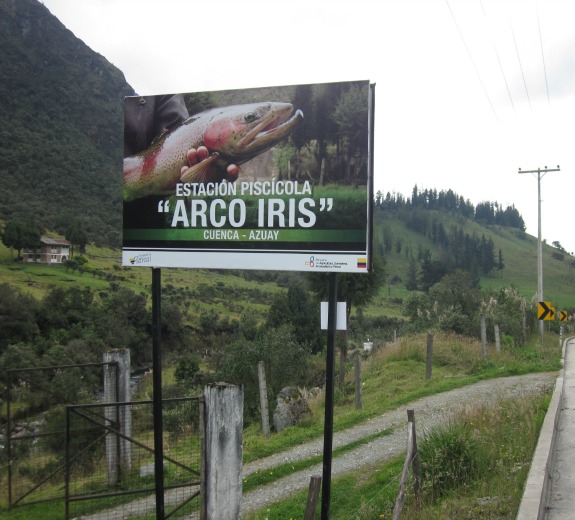
Billboards and advertisements depicting huge and beautiful rainbow trout announce to travelers in much of the Ecuadorian Andes that fishing is one reason to come here. Photo by Alastair Bland.
“What kind of trout live in here?” I ask a young man who serves me coffee at Cabana del Pescador, the campground where I have stayed the night. I am only curious how locals refer to the species Oncorhynchus mykiss, which is native to North American and Siberian streams that enter the Pacific but has been introduced to virtually all suitable habitat on earth. In Ecuador, the species first arrived in the 1960s.
“Normal trout,” he says.
I aim to catch a few fish today and have them for dinner, but I move on, up the road, looking for a happier place to fish. The pond here is muddy, surrounded by concrete and a chain-link fence. Trouble is, I won’t find much better. This valley, though populated by a few wild trout in the streams and lakes of Cajas National Park, is a busy center of aquaculture. Trout farming is generally considered a clean and sustainable industry, though it isn’t always pretty. For a stretch of seven or eight miles downstream of the park, nearly every roadside farm has a handful of concrete-banked pools on the premises, fed by stream water and swarming with trout about 12 inches long.
Up the road, after passing a half dozen possible fishing sites, I pull in to one called Reina del Cisne, at kilometer 21. It is a restaurant and sport fishing “club,” as the sign tells visitors. I have coffee—Nescafé, as always—inside. When I am finished, I ask if there is an opportunity to fish here, and the teenage waiter beckons me to follow. “It’s 50 cents to rent a pole,” he says. “Then, we weigh the trout, and you pay $2.25 per pound.” The biggest fish in the ponds out back are more than ten pounds, he tells me.
He pulls one rod from a heap of several dozen—a broomstick-like pole with a stout line tied to the end and a silver barbed hook at the tip. He quickly mixes up a bucket of bread dough to use as bait, drops a hunk into a shopping-style woven basket and hands me my tackle.
“What kind of trout are these?” I ask, still fishing for local lingo.
“Salmon trout. They have red meat,” he says. He adds, “Good luck,” and returns to the restaurant.
For an angler who has fished in the Rockies and the Sierra Nevada and Alaska and New Zealand, this is a sad comparison, and I feel a strange desire to either cry or laugh hysterically. This would make a perfect opportunity for kids, but I know what real fishing, in real waters, is. Here, I have three ponds to choose from—two of them rectangular, concrete basins, the other a muddy, oval-shaped pool 30 feet across with grassy banks. I flick a piece of dough into this most natural-appearing of the options. Several trout dart from the murk as the white ball vanishes in an instant. I bait my hook and fling it into the middle of the pond, slightly embarrassed that I am participating in what locals advertise as pesca deportiva—or “sport fishing.” A similar flurry of fish attack and strip the hook. I re-bait and try again and this time hook instantly into a feisty rainbow. I drag it in and onto the bank, whack it cold with a stick and drop it in my basket. One down, and in another five minutes I have a second fish. I could take more but, frankly, this isn’t fun or engaging. A year ago exactly I was cycling around New Zealand, casting flies at wild trout six times this size and immeasurably more thrilling to catch—wary, elusive, picky and beautiful. The challenge of enticing one to strike made success an accomplishment. Best of all was the experience of being there, fish or none, standing in crystal clear waters surrounded by green meadows and the tall peaks of the Southern Alps. Indeed, fishing is largely about interacting with the environment, and if one catches no trout on an expedition into the mountains, something else is still gained.
But no matter how big a fish one may pull from a concrete-lined pond, using dough balls for bait, the experience feels as hollow as shopping in a supermarket. While I’m here, I hope I might tangle with an eight-pounder, but no such beast shows itself. I wonder if perhaps they tell all guests that giant trout live in these ponds to encourage business. But back inside the restaurant, my hosts show me the de-boned meat of a 14-pounder caught the day before. The meat is thick and heavy and a delicious-looking salmon red. I ask what the trout eat. “Natural food,” owner Maria Herrera tells me.
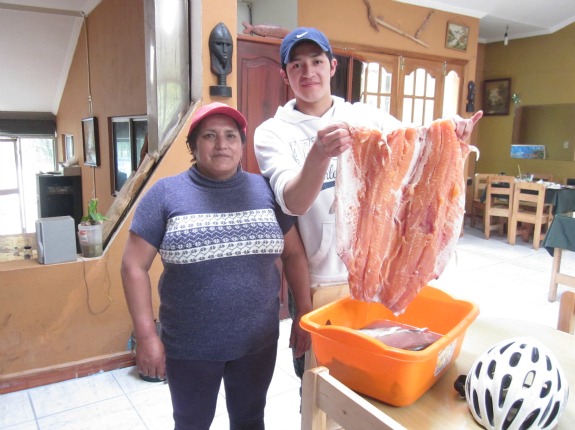
Maria Herrera, in the dining room of her restaurant Reina del Cisne, stands with a young employee and the de-boned meat of a 14-pound trout taken from the stocked fish tanks in back. Photo by Alastair Bland.
Outside, they show me a rectangular basin teeming with huge rainbows, green-backed, red-sided beauties that remind me of the two-foot-long giants of New Zealand. Visitors may come here to buy these trout, Moreno tells me. The fish go for $1.50 per pound.
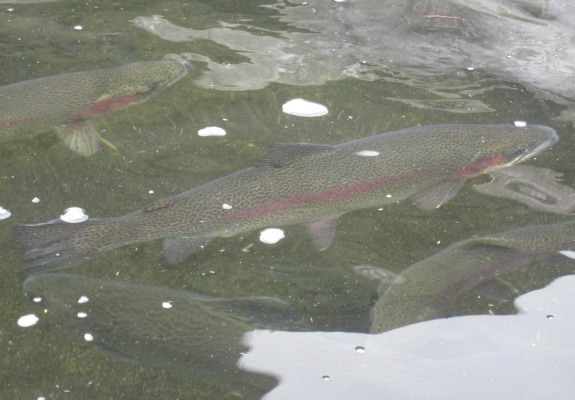
Five- and six-pound rainbow trout cruise through the waters of a 6- by 30-foot concrete basin at a government trout hatchery and farm at kilometer 18 on the Cuenca-Cajas National Park highway. Photo by Alastair Bland.
This doesn’t surprise me. The rainbow trout I grew up on were generally white-fleshed fish. Only occasionally on family camping trips as we cleaned our catch would we discover with excitement that the trout had natural pink meat, which tends to be richer and fattier than paler flesh. But in Ecuador’s many fish markets, I have not yet seen a trout fillet that wasn’t colored like salmon, and I’ve suspected all along that this attractive color (which I’ll admit has drawn my wallet from my pocket more than once) was artificially induced. I recall seeing the fillet of a trout caught in New Zealand just outside the outflow of a Chinook salmon farm that was clearly affected by such pigment—probably either synthetic astaxanthin or canthaxanthin, both used in most commercial salmon farming operations (and the latter of which may cause retinal damage). The trout had presumably been eating pellet feed that escaped from the salmon pens, and the meat was partially colored, patchy red and white like a tie-dyed shirt. Yuck.
I poached my farm-caught trout in cheap Chilean Sauvignon Blanc at my hostel in Cuenca, just off the main street of Calle Larga. The meal was fine and exactly what I had been aiming for when I plunked that ball of dough into the pond at Reina del Cisne. But the fish didn’t quite taste up to par. Because although pink-fleshed trout are a sure catch in the mountain fishing ponds of Ecuador, something else, less easy to describe, native to places like Montana and British Columbia, may evade you with every fish landed.
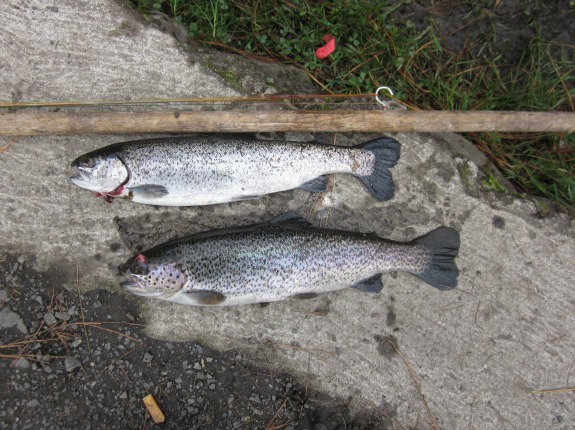
Neither native nor wild, these small rainbow trout were pulled from a stocked pond in Ecuador, where the species was introduced in the 1960s. Photo by Alastair Bland.
Read more: http://blogs.smithsonianmag.com/adventure/2013/02/trout-fishing-in-ecuador/#ixzz2L3W5D0sD
Follow us: @SmithsonianMag on Twitter
More Fishing News: http://gofishtalk.com
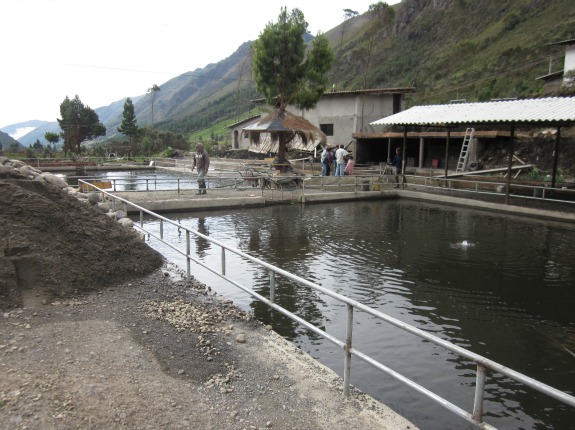
No comments:
Post a Comment